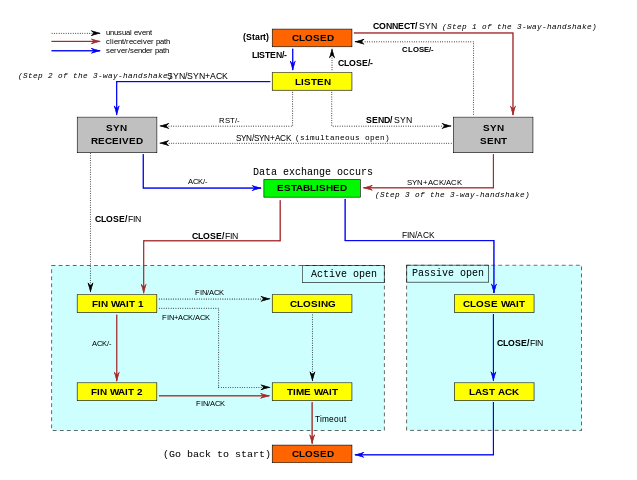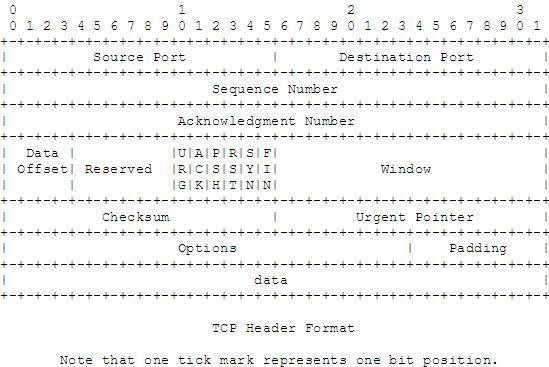Operating Systems Lecture Notes
9 April 2012 • Transport Services
Outline
- Transport protocols: UDP and TCP.
- Transport abstractions and APIs.
- TCP
- Implementing TCP.
- TCP segments and packets.
- Flow and congestion control.
Level 4
- ISO OSI level 4: transport services.
- The transport level ties together individual networks into a single
network.
- Initially via overlay networks, now more directly.
- Uniform addressing, and a small amount of global structure.
Transport Protocols
- Transmission control protocol (TCP) and the user
datagram protocol (UDP) are two major transport protocols.
- TP4 is ISO’s failed entry.
- Most other examples also lost to TCP/IP.
- The operating system is responsible for implementing the protocol.
- The networking subsystem, in particular.
UDP
- UDP provides a few simple end-to-end services:
- Per-host multiplexing via 16-bit port numbers.
- Unreliable datagram delivery.
- A datagram is a block of data (not as structured as a message).
- “Unreliable” means: loss, corruption, duplication, unordered.
TCP
- TCP an overtly simpler but covertly more complex protocol.
- TCP services include:
- Per-host multiplexing over 16-bit port numbers (independent of UDP).
- Reliable byte streams.
- “Reliable” means: uncorrupted, ordered.
Transport Abstractions
- Transport services initially look typical: data gets written, data
gets read. But
- Different read-write patterns (reliability, network delay).
- Complex transport-services characterizations.
- Transport services should look like other information-oriented
services.
- With some control-oriented services too.
- A lot like files.
Transport APIs
- Transport services should be available through file-like APIs.
- And sometimes they are.
- Unfortunately, the Sockets API from BSD Unix won the race.
- The Sockets API is a perfect example of what happens when you violate the YAGNI principle.
Connections
- TCP is connection-oriented.
- A connection is a long-term, explicit relation between communicating end-points.
- Binding establishes one end of a connection.
- UDP is connection-less.
- But the end-point terminology carries through.
TCP Connection States
- Much complexity (TCP or Sockets) arises from connection states.
- A rough list of states include:
- Bound or unbound: connection end-points assigned or not.
- Connected or listening: both end-point bound or not.
- Closed: amazingly complex (half-closed, time waiting).
- UDP avoids this.
TCP States Illustrated

Implementing TCP
- The operating system implements the TCP reliable byte-stream
abstraction.
- Operating system → networking subsystem → TCP protocol stack.
- Byte-stream reliability comes from acknowledgments and
timeout-retransmission.
- Send data blocks.
- Get acknowledgment and move on, or
- timeout and retransmit.
Network Management
- The TCP protocol stack should also react to network conditions, and
conditions at the other end.
- Congestion and flow control.
- Both are based on varying the block-write characteristics.
- Sending rate and, less variably, sending size.
TCP Segments
- The data blocks sent and received are called segments.
- Buffering’s important in TCP.
- Assembling data into segments.
- Holding segments for retransmission.
- Many games are possible by manipulating TCP buffering.
- Slow start, Nagle’s algorithm.
TCP Packets
- A segment is preceded by a TCP header to form a TCP packet.

Flow Control
- For best throughput, send everything at once.
- Receiver hostile, particularly for less capable receivers.
- Keep the number of unacknowledged packets at some maximum value, the window size.
- As packets get acknowledged, shift the window further up the data stream.
- This is window-based flow control.
Congestion Control
- For best throughput, send everything at once.
- Network hostile as a global behavior.
- Keep the number of unacknowledged packets at the window size.
- As packets get acknowledged, send more and increase the window size.
- Acknowledgment time-outs reduce the window size.
- This is slow-start congestion control.
Summary
- Transport services are the most convenient (most abstract) of the ISO
networking services.
- But even then they’re not so great.
- Transport services are end-to-end.
- TCP and UDP are the best known, most used transport protocols.
- TCP: reliable byte streams.
- UDP: best-effort datagrams.
References
- Transmission Control Protocol, RFC 793, 1981.
- User Datagram Protocol, RFC 768, by Jon Postel, 1980.
Credits
- TCP state diagram.jpg by Raul654 under a Creative Commons BY SA license.
- Ntwk tcp header123.jpg by Gopal Paliwal under a Creative Commons BY SA license.
| This page last modified on 2012 April 11. |
